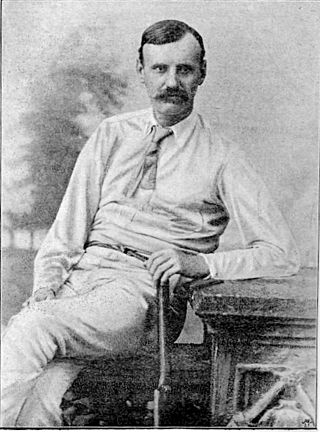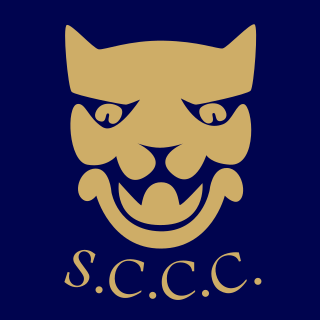Related Research Articles
First-class cricket, along with List A cricket and Twenty20 cricket, is one of the highest-standard forms of cricket. A first-class match is one of three or more days' scheduled duration between two sides of eleven players each and is officially adjudged to be worthy of the status by virtue of the standard of the competing teams. Matches must allow for the teams to play two innings each, although in practice a team might play only one innings or none at all.

Worcestershire County Cricket Club is one of eighteen first-class county clubs within the domestic cricket structure of England and Wales. It represents the historic county of Worcestershire. Its Vitality Blast T20 team has been rebranded the Worcestershire Rapids, but the county is known by most fans as 'the Pears'. The club is based at New Road, Worcester. Founded in 1865, Worcestershire held minor status at first and was a prominent member of the early Minor Counties Championship in the 1890s, winning the competition three times. In 1899, the club joined the County Championship and the team was elevated to first-class status. Since then, Worcestershire have played in every top-level domestic cricket competition in England.

Oxford University Cricket Club (OUCC), which represents the University of Oxford, had held first-class status since 1827 when it made its debut in the inaugural University Match between OUCC and Cambridge University Cricket Club (CUCC). Following the 2021 University Match, OUCC lost its first-class status. It was classified as a List A team in 1973 only. Home fixtures are played at the University Parks slightly northeast of Oxford city centre.

Cambridge University Cricket Club, established in 1820, is the representative cricket club for students of the University of Cambridge. Depending on the circumstances of each individual match, the club has always been recognised as holding first-class status. The university played List A cricket in 1972 and 1974 only. It has not played top-level Twenty20 cricket.

Derbyshire County Cricket Club is one of eighteen first-class county clubs within the domestic cricket structure of England and Wales. It represents the historic county of Derbyshire. Its limited overs team is called the Derbyshire Falcons in reference to the famous peregrine falcon which nests on the Derby Cathedral. Founded in 1870, the club held first-class status from its first match in 1871 until 1887. Because of poor performances and lack of fixtures in some seasons, Derbyshire then lost its status for seven seasons until it was invited into the County Championship in 1895. Derbyshire is also classified as a List A team since the beginning of limited overs cricket in 1963; and classified as a senior Twenty20 team since 2003. In recent years the club has enjoyed record attendances with over 24,000 people watching their home Twenty20 fixtures in 2017 – a record for a single campaign. The local derby versus Yorkshire at Chesterfield now regularly sells out in advance.

William Barnes was an English professional cricketer who played for Nottinghamshire County Cricket Club from 1875 to 1894, and in 21 Test matches for England from 1880 to 1890. He was born at Sutton-in-Ashfield, Nottinghamshire, and died at Mansfield Woodhouse, Nottinghamshire.

Shropshire County Cricket Club is one of twenty minor county clubs within the domestic cricket structure of England and Wales. It represents the historic county of Shropshire.
In English cricket, the years 1826–1845 were dominated by the roundarm bowling issue, which was resolved when the style was legalised in 1835, and by the formation of the first modern county clubs between 1839 and 1845.
The Sheffield Cricket Club was founded in the 18th century and soon began to play a key role in the development of cricket in northern England. It was the direct forerunner of Yorkshire County Cricket Club and some of the teams fielded by Sheffield were styled Yorkshire. Sheffield generally held first-class status, depending on the quality of their opponents, from 1827 to 1855.
The University Match in a cricketing context is generally understood to refer to the annual fixture between Oxford University Cricket Club and Cambridge University Cricket Club.
The 1786 English cricket season was the 15th in which matches have been awarded retrospective first-class cricket status and the last before the Marylebone Cricket Club was founded in 1787. The season saw five top-class matches played in the country.
The 1788 English cricket season was the 17th in which matches have been awarded retrospective first-class cricket status and the second after the foundation of the Marylebone Cricket Club. The season saw 11 first-class matches played in the country.
The 1793 English cricket season was the 22nd in which matches have been awarded retrospective first-class cricket status and the seventh after the foundation of the Marylebone Cricket Club. The season saw 17 top-class matches played in the country.
1804 was the 18th season of cricket in England since the foundation of Marylebone Cricket Club (MCC). The first Eton v Harrow match may have been played at Lord's Old Ground.
Albert Edward Clapp was an English professional cricketer who played for Somerset and Shropshire between 1885 and 1895. He played most of his career in the second tier of county cricket, but did appear ten times for Somerset in first-class cricket. A right-handed batsman, Clapp began his career playing first-class cricket with Somerset in 1885, and from 1891 he alternated between both Somerset and Shropshire. He made his final county appearance in 1896, while his final recorded match was two years later. He achieved his highest first-class score of 60 not out against Hampshire in his penultimate first-class match.
John Deedes was an amateur English first-class cricketer.

Christ Church Ground is a cricket ground in Oxford, England. The ground is owned by Christ Church, a constituent college of the University of Oxford. Privately owned, it was the preferred venue in Oxford for matches where a gated admission was to be levied on spectators, typically in matches between Oxford University and a touring international team. The ground was a first-class cricket venue from 1878 to 1961, hosting 37 first-class matches. After 1961, the University Parks became the preferred venue for all first-class matches in Oxford, but it remained in use in minor counties and one-day cricket by Oxfordshire until the start of the 21st century and hosted a Women's One Day International during the 1993 Women's Cricket World Cup.
John Abercrombie was an English first-class cricketer. Abercrombie's batting style is unknown.
Left-Handed v Right-Handed was an occasional first-class cricket fixture held in England between 1790 and 1870. There were four such fixtures in all where a team titled "Left-Handed" played a team titled "Right-Handed". Additionally, a left-handed team played in two other matches against Marylebone Cricket Club (MCC). There are no instances of a right-handed team except in the four matches against left-handed teams.
Through the Napoleonic Wars, county cricket virtually died as cricket was impacted by losses of investment and manpower.
References
- 1 2 "First-Class Matches played by Single". CricketArchive. Retrieved 28 May 2013.
- ↑ "First-Class Matches played by Married". CricketArchive. Archived from the original on 7 March 2016. Retrieved 28 May 2013.
- ↑ "Married v Single, 1829". CricketArchive. Retrieved 28 May 2013.